![SlaveNarrative1]()
Voices from the past were resurrected to give testimony to the reality, angst and cruelty of human beings in chattel enslavement in the U.S. at “A Reading of
Slave Narratives” during Southern Illinois University Edwardsville’s Black Heritage Month.
SIUE’s Black Theatre Workshop and the Black Studies Program presented the dramatic reading on Monday, Feb. 10 at the Center for Student Diversity and Inclusion (CSDI). Bryan Jack, PhD, associate professor in the Department of Historical Studies, moderated the discussion.
“When I began to work, I discovered the difference between myself and my master’s white children. They began to order me about, and were told to do so by my master and mistress,” read senior Kiara Ulmer, from the slave account of
Lunsford Lane. “I found, too, that they had learned to read, while I was not permitted to have a book in my hand. To be in the possession of anything written or printed, was regarded as an offence.”
“At the time I was sold … my poor mother, when she saw me leaving her for the last time, ran after me, took me down from the horse, clasped me in her arms, and wept loudly and bitterly over me,” read senior Avalon Palmer, from the slave narrative of
Charles Ball. “My mother then turned to him and cried, ‘Oh, master, do not take me from my child!’ Without making any reply, he gave her two or three heavy blows on the shoulders with his raw hide, snatched me from her arms, handed me to my master.”
“How does it feel to hear the words from people who were enslaved?” asked Jack.
![SlaveNarrative2]()
“It’s horrid. It hurts to hear it,” replied one audience member. “You can feel their pain.”
“Think about Lunsford’s words in his slave narrative title, ‘Embracing an account of his early life, the redemption by purchase of himself and family from slavery, and his banishment from the place of his birth for the crime of wearing a colored skin,’” said Jack. “We are fortunate to have their accounts, but we only have access to a miniscule amount of information from the slaves themselves.”
One slave chronicle that was read came from a more notable black history figure –
Frederick Douglass.
“Why am I a slave? Why are some people slaves and others masters? These were perplexing questions and very troublesome to my childhood,” read freshman Rhonda Whitter, from Frederick Douglass’ slave history. “I was very early told by some one that ‘God up in the sky’ had made all things, and had made black people to be slaves and white people to be masters. I was told too that God was good, and that He knew what was best for everybody. This was, however, less satisfactory than the first statement. It came point blank against all my notions of goodness … Besides, I could not tell how anybody could know that God made black people to be slaves. Then I found, too, that there were puzzling exceptions to this theory of slavery, in the fact that all black people were not slaves, and all white people were not masters.”
Another slave description came from
Lucy Ann Delaney, who wrote the only first-person account of a “freedom suit” regarding legal battles in St. Louis, which was a forerunner to the landmark decision of Brown v Board of Education.
“I was beginning to plan for freedom, and was forever on the alert for a chance to escape and join my sister. I was then 12 years old, and often talked the matter over with mother and canvassed the probabilities of both of us getting away,” read freshman Neshay Sanders, of Delaney’s slave narrative. “No schemes were too wild for us to consider! Mother was especially restless, because she was a free woman up to the time of her being kidnapped, so the injustice and weight of slavery bore more heavily upon her than upon me . . . My mother returned to the house to get her few belongings, and straining me to her breast, begged me to be a good girl, that she was going to run away, and would buy me as soon as she could. With all the inborn faith of a child, I believed it most fondly, and when I heard that she had actually made her escape, three weeks after, my heart gave an exultant throb and cried, ‘God is good!’”
Concluding the dramatic readings was Kathryn Bentley, associate professor in the Department of Theater and Dance, with her emotional rendering of
Sojourner Truth’s slave story.
“I was often surprised to find my mother in tears; and I asked ‘Mau-mau, what makes you cry?’ She would answer, ‘Oh, my child, I am thinking of your brothers and sisters that have been sold away from me,’” read Bentley. “… In the evening, when my mother’s work was done, she would sit down under the sparkling vault of heaven, and calling her children to her, would talk to us of the only Being that could effectually aid or protect us … ‘My children, there is a God, who hears and sees you … He lives in the sky, and when you are beaten, or cruelly treated, or fall into any trouble, you must ask help of him, and he will always hear and help you.’”
For a complete list of Black Heritage Month events, visit
Black and Unified.
Photos:
Participating in “A Slave Narrative” presentation (L-R): Bryan Jack, PhD, associate professor in the Department of Historical Studies; senior Kiara Ulmer, freshman Rhonda Whittier, Kathryn Bentley, associate professor in the Department of Theater and Dance; senior Avalon Palmer; and freshman Neshay Sanders.
Sanders reads an account from Lucy Ann Delaney.
![]()
 The Southern Illinois University Edwardsville School of Pharmacy in association with The American Diabetes Association is hosting the 14th annual Free Diabetes Education Program at SIUE’s Morris University Center from 8 a.m.-12:45 p.m. Saturday, Feb. 29.
The Southern Illinois University Edwardsville School of Pharmacy in association with The American Diabetes Association is hosting the 14th annual Free Diabetes Education Program at SIUE’s Morris University Center from 8 a.m.-12:45 p.m. Saturday, Feb. 29.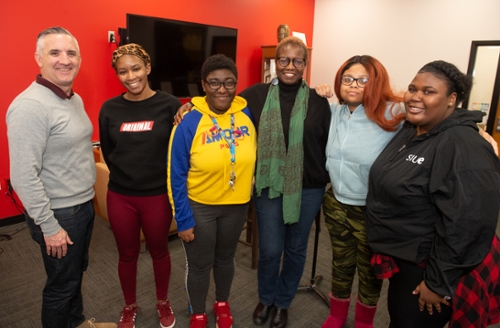 Voices from the past were resurrected to give testimony to the reality, angst and cruelty of human beings in chattel enslavement in the U.S. at “A Reading of
Voices from the past were resurrected to give testimony to the reality, angst and cruelty of human beings in chattel enslavement in the U.S. at “A Reading of 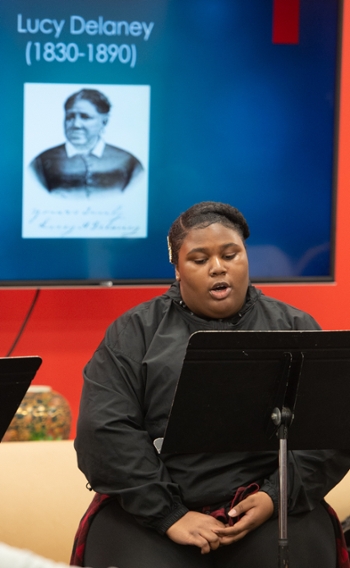 “It’s horrid. It hurts to hear it,” replied one audience member. “You can feel their pain.”
“It’s horrid. It hurts to hear it,” replied one audience member. “You can feel their pain.” 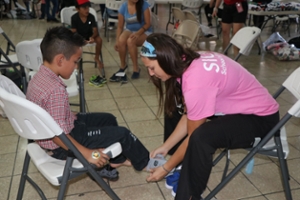 Southern Illinois University Edwardsville’s commitment to service was on display for the third consecutive year as the School of Nursing (SON) took a 12-person team comprised of students and faculty to Costa Rica Jan. 4-11, where they saw approximately 850 patients in four days at different locations.
Southern Illinois University Edwardsville’s commitment to service was on display for the third consecutive year as the School of Nursing (SON) took a 12-person team comprised of students and faculty to Costa Rica Jan. 4-11, where they saw approximately 850 patients in four days at different locations.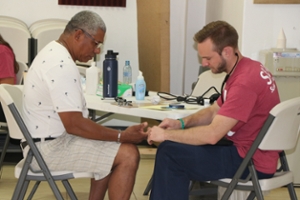 Tanzyus described his encounter with a little boy who talked to him in Spanish. “I asked one of the translators, as I couldn’t understand what he was trying to ask,” he said. “The translator looked at me with a smile, ‘He is asking when you will be back.’ My eyes filled with tears as I tried to hold back my emotion.
Tanzyus described his encounter with a little boy who talked to him in Spanish. “I asked one of the translators, as I couldn’t understand what he was trying to ask,” he said. “The translator looked at me with a smile, ‘He is asking when you will be back.’ My eyes filled with tears as I tried to hold back my emotion.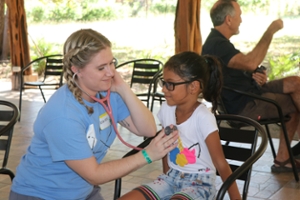 “One of the real-life lessons I want to remember is patience and kindness, because nothing is so stressful that anyone deserves anything less. If people with nearly nothing can find happiness and treat people with kindness all the time, so can I. As I move forward in life, I will seek opportunity to help others whenever I can. I will pay it forward by performing simple or small random acts of kindness. Everyone can benefit from kindness and humility.”
“One of the real-life lessons I want to remember is patience and kindness, because nothing is so stressful that anyone deserves anything less. If people with nearly nothing can find happiness and treat people with kindness all the time, so can I. As I move forward in life, I will seek opportunity to help others whenever I can. I will pay it forward by performing simple or small random acts of kindness. Everyone can benefit from kindness and humility.”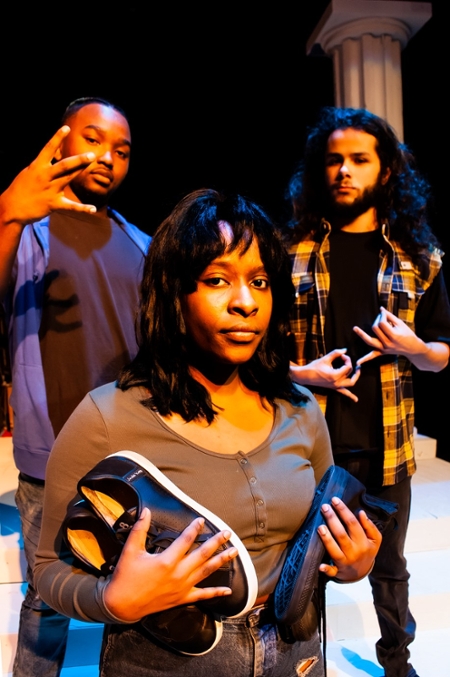 Violence and death. They are as old as humankind is, but through the ages, the narratives and means have changed. Southern Illinois University Edwardsville Department of Dance and Theater Associate Professor Kathryn Bentley will direct “XTIGONE,” a play about urban violence, written by award-winning playwright and actress Nambi Kelley, and performed by SIUE students.
Violence and death. They are as old as humankind is, but through the ages, the narratives and means have changed. Southern Illinois University Edwardsville Department of Dance and Theater Associate Professor Kathryn Bentley will direct “XTIGONE,” a play about urban violence, written by award-winning playwright and actress Nambi Kelley, and performed by SIUE students. 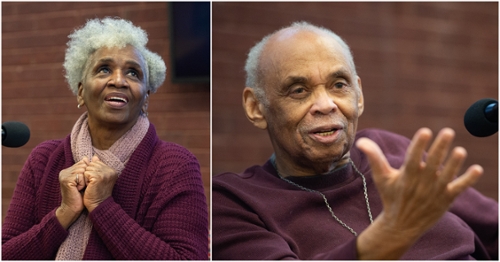 Eighty-four-year-old
Eighty-four-year-old 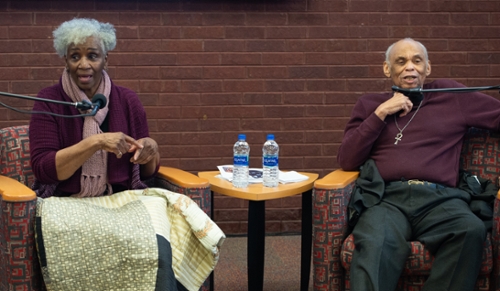 During their discussion, the couple also noted the exploits of African Americans, mostly from East St. Louis.
During their discussion, the couple also noted the exploits of African Americans, mostly from East St. Louis.  The program engaged students pursuing a variety of majors, including industrial, mechanical and mechatronics engineering, computer science, computer management and information systems, business administration with a focus on entrepreneurship, art and more.
The program engaged students pursuing a variety of majors, including industrial, mechanical and mechatronics engineering, computer science, computer management and information systems, business administration with a focus on entrepreneurship, art and more. Sutter’s team pitched a system that collects water from downspouts to create energy.
Sutter’s team pitched a system that collects water from downspouts to create energy. The Southern Illinois University Board of Trustees today approved a tuition freeze for the second consecutive year for all new undergraduate students at SIUE, effective fall 2020. The board met on the Edwardsville campus.
The Southern Illinois University Board of Trustees today approved a tuition freeze for the second consecutive year for all new undergraduate students at SIUE, effective fall 2020. The board met on the Edwardsville campus.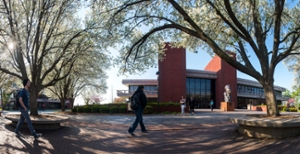 The Southern Illinois University Board of Trustees today maintained the general student fee (GSF) charge for the Edwardsville campus for the fall and spring terms of the 2020-21 academic year. The board’s decision came at its meeting on the Edwardsville campus.
The Southern Illinois University Board of Trustees today maintained the general student fee (GSF) charge for the Edwardsville campus for the fall and spring terms of the 2020-21 academic year. The board’s decision came at its meeting on the Edwardsville campus. The Southern Illinois University Board of Trustees, at its regularly scheduled meeting on the Edwardsville campus today, approved contracts totaling more than $7.4 million toward the School of Dental Medicine’s (SDM) Advanced Care Clinic (ACC) at the Alton campus.
The Southern Illinois University Board of Trustees, at its regularly scheduled meeting on the Edwardsville campus today, approved contracts totaling more than $7.4 million toward the School of Dental Medicine’s (SDM) Advanced Care Clinic (ACC) at the Alton campus. 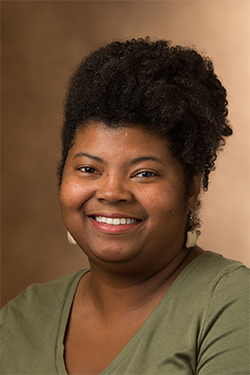 SIUE’s Danielle Lee, PhD, assistant professor in the College of Arts and Sciences’ Department of Biological Sciences, shared her insight on dog domestication and what science says about dogs’ love in a NOVA documentary titled “Dog Tales.”
SIUE’s Danielle Lee, PhD, assistant professor in the College of Arts and Sciences’ Department of Biological Sciences, shared her insight on dog domestication and what science says about dogs’ love in a NOVA documentary titled “Dog Tales.”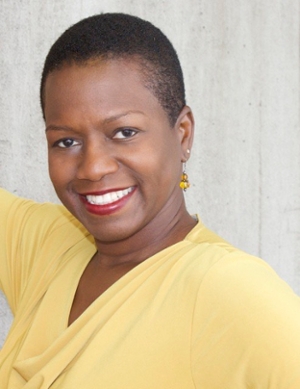 Southern Illinois University Edwardsville Department of Theater and Dance Associate Professor and Black Studies program Director Kathryn Bentley has earned a 2020 Saint Louis Visionary Award in the Outstanding Working Artist category. The award celebrates Bentley’s acclaimed work in the arts both at SIUE and in the community.
Southern Illinois University Edwardsville Department of Theater and Dance Associate Professor and Black Studies program Director Kathryn Bentley has earned a 2020 Saint Louis Visionary Award in the Outstanding Working Artist category. The award celebrates Bentley’s acclaimed work in the arts both at SIUE and in the community. Southern Illinois University Edwardsville Department of English Language and Literature Assistant Professor Tiana Clark has been named one of five finalists in the prestigious 2020 Kate Tufts Discovery Award for her poetry book, “I Can’t Talk About the Trees Without the Blood.”
Southern Illinois University Edwardsville Department of English Language and Literature Assistant Professor Tiana Clark has been named one of five finalists in the prestigious 2020 Kate Tufts Discovery Award for her poetry book, “I Can’t Talk About the Trees Without the Blood.”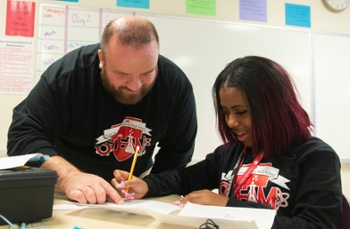 It was a day of skill, wit, challenge, experimentation and fun that yielded a time of learning in the areas of science, technology, engineering, arts and mathematics (STEAM) that instructors hope will incite their students’ desire for learning well into the future.
It was a day of skill, wit, challenge, experimentation and fun that yielded a time of learning in the areas of science, technology, engineering, arts and mathematics (STEAM) that instructors hope will incite their students’ desire for learning well into the future. 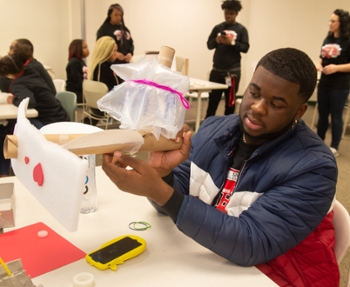 Throughout the day, groups of CHS students rotated through the following challenges:
Throughout the day, groups of CHS students rotated through the following challenges: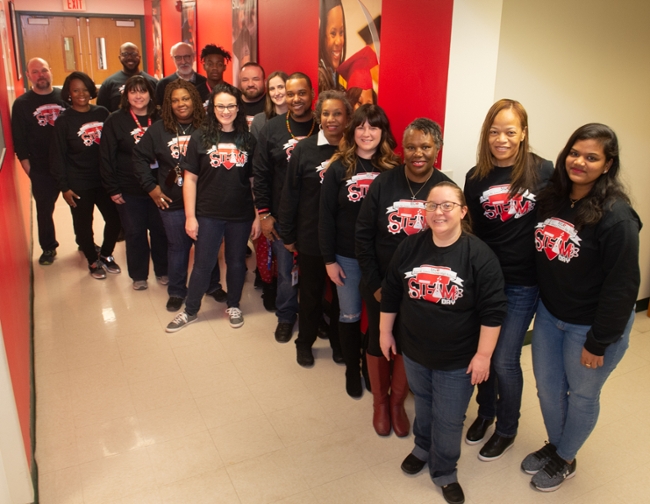 Brandon Moore, CHS senior, proudly showed off his group’s invention. “It makes those who hear it fall in love with the person playing,” said Moore, as he mocked playing the “Love Instrument.” “It is like a flute, but it has no holes.”
Brandon Moore, CHS senior, proudly showed off his group’s invention. “It makes those who hear it fall in love with the person playing,” said Moore, as he mocked playing the “Love Instrument.” “It is like a flute, but it has no holes.”  The Institute of Internal Auditors (IIA) Academic Relations Committee (ARC) has accepted Southern Illinois University Edwardsville’s School of Business into its Internal Auditing Education Partnership Program (IAEP) program as an IAEP Internal Audit Foundation Program.
The Institute of Internal Auditors (IIA) Academic Relations Committee (ARC) has accepted Southern Illinois University Edwardsville’s School of Business into its Internal Auditing Education Partnership Program (IAEP) program as an IAEP Internal Audit Foundation Program.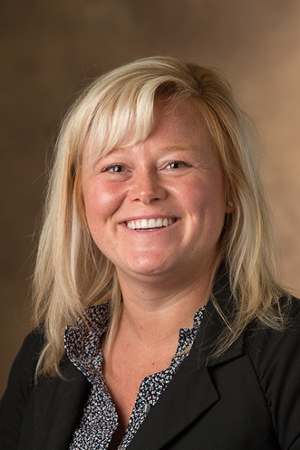 Hoelscher said the process took years of work and collaboration between the SIUE Department of Accounting faculty and the St. Louis IIA Chapter. SIUE had to demonstrate a commitment to offering internal audit-related coursework in its curriculum by qualified faculty. Extensive documentation was warranted to show course offerings, course availability, faculty qualifications, faculty contributions to the profession and a resources commitment to ensure students get appropriate exposure to the necessary coursework.
Hoelscher said the process took years of work and collaboration between the SIUE Department of Accounting faculty and the St. Louis IIA Chapter. SIUE had to demonstrate a commitment to offering internal audit-related coursework in its curriculum by qualified faculty. Extensive documentation was warranted to show course offerings, course availability, faculty qualifications, faculty contributions to the profession and a resources commitment to ensure students get appropriate exposure to the necessary coursework. 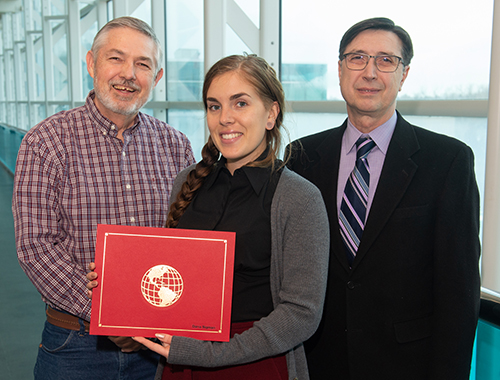 Southern Illinois University Edwardsville School of Engineering alumna Dana Sigman and College of Arts and Sciences (CAS) senior Brett Bertok are one step closer to leading lives full of educated and impassioned global service.
Southern Illinois University Edwardsville School of Engineering alumna Dana Sigman and College of Arts and Sciences (CAS) senior Brett Bertok are one step closer to leading lives full of educated and impassioned global service.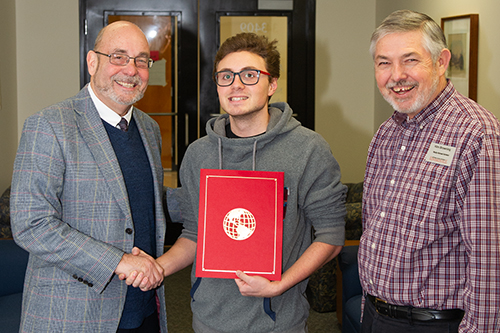 Bertok, of Hoffman Estates, is slated to achieve a bachelor’s in geography with a minor in French in May 2020. He transferred to SIUE specifically to pursue the Peace Corps Prep program and quickly fell in love with the geography program. Bertok aims to complete a master’s in geography at SIUE, and then hopes to serve in the Peace Corps.
Bertok, of Hoffman Estates, is slated to achieve a bachelor’s in geography with a minor in French in May 2020. He transferred to SIUE specifically to pursue the Peace Corps Prep program and quickly fell in love with the geography program. Bertok aims to complete a master’s in geography at SIUE, and then hopes to serve in the Peace Corps.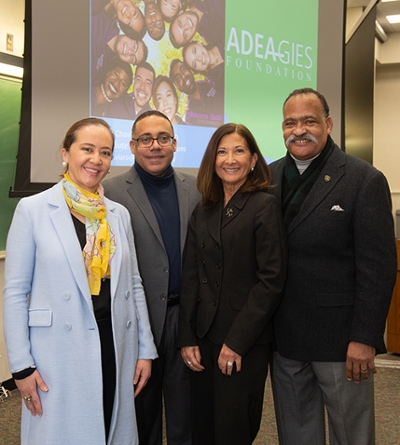 Southern Illinois University School of Dental Medicine (SIU SDM) students’ eyes were opened to the wide world of career possibilities within the dentistry profession beyond the clinic, with a focus on the significance of academia, diversity, inclusion, leadership and mentorship.
Southern Illinois University School of Dental Medicine (SIU SDM) students’ eyes were opened to the wide world of career possibilities within the dentistry profession beyond the clinic, with a focus on the significance of academia, diversity, inclusion, leadership and mentorship.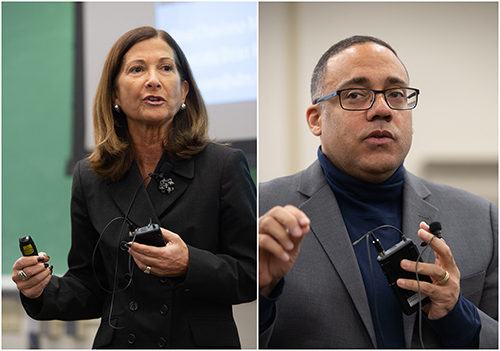 “As dentists, we are clinicians,” said Chaviano-Moran, “but, we want to empower students to know that there are other opportunities within dentistry, such as becoming involved in academia and leadership, and seeking ways to meet and network with fellow clinicians and scholars. We want to plant the seed that there are numerous opportunities, and promote that students have to water their own grass and look for different perspectives to grow.”
“As dentists, we are clinicians,” said Chaviano-Moran, “but, we want to empower students to know that there are other opportunities within dentistry, such as becoming involved in academia and leadership, and seeking ways to meet and network with fellow clinicians and scholars. We want to plant the seed that there are numerous opportunities, and promote that students have to water their own grass and look for different perspectives to grow.”